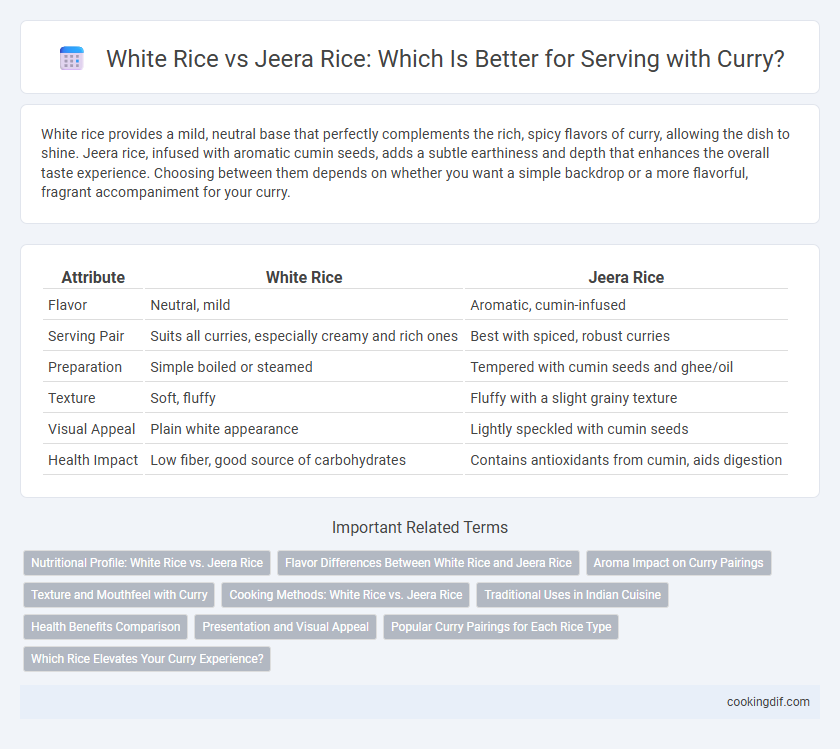White rice provides a mild, neutral base that perfectly complements the rich, spicy flavors of curry, allowing the dish to shine. Jeera rice, infused with aromatic cumin seeds, adds a subtle earthiness and depth that enhances the overall taste experience. Choosing between them depends on whether you want a simple backdrop or a more flavorful, fragrant accompaniment for your curry.
Table of Comparison
| Attribute | White Rice | Jeera Rice |
|---|---|---|
| Flavor | Neutral, mild | Aromatic, cumin-infused |
| Serving Pair | Suits all curries, especially creamy and rich ones | Best with spiced, robust curries |
| Preparation | Simple boiled or steamed | Tempered with cumin seeds and ghee/oil |
| Texture | Soft, fluffy | Fluffy with a slight grainy texture |
| Visual Appeal | Plain white appearance | Lightly speckled with cumin seeds |
| Health Impact | Low fiber, good source of carbohydrates | Contains antioxidants from cumin, aids digestion |
Nutritional Profile: White Rice vs. Jeera Rice
White rice contains approximately 130 calories and 28 grams of carbohydrates per cooked cup, providing a simple, neutral base for curries but lacking significant micronutrients. Jeera rice, made with cumin seeds, retains similar calories and carbs but adds antioxidants, iron, and small amounts of dietary fiber due to the cumin infusion, enhancing the overall nutritional value. The inclusion of cumin in jeera rice offers digestive benefits and essential minerals that white rice alone does not provide, making it a nutritionally superior option for curry pairings.
Flavor Differences Between White Rice and Jeera Rice
White rice offers a neutral and mild flavor that serves as a versatile base for flavorful curries, allowing the spices and sauces to shine. Jeera rice, infused with cumin seeds, introduces a warm, earthy aroma and subtle nutty taste that enhances the overall dining experience by complementing spicy and rich curry dishes. The distinct cumin flavor in jeera rice adds depth and complexity, making it an ideal accompaniment for Indian and South Asian curries.
Aroma Impact on Curry Pairings
White rice offers a neutral aroma that allows the rich spices of curry to stand out prominently, making it a versatile pairing for a variety of curry flavors. Jeera rice, infused with cumin seeds, adds a warm, earthy fragrance that complements and enhances the aromatic spices in many Indian curries. The subtle cumin aroma in Jeera rice can elevate the overall sensory experience, creating a harmonious balance between the rice and curry spices.
Texture and Mouthfeel with Curry
White rice offers a soft, fluffy texture that absorbs curry sauces seamlessly, enhancing the overall mouthfeel by complementing the creamy consistency of many curries. Jeera rice, infused with cumin seeds, provides a slightly firmer grain with a subtle nutty flavor and aromatic profile, creating a more textured and fragrant pairing that balances rich or spicy curry dishes. The choice between the two depends on whether a smooth, neutral base or a flavorful, textured accompaniment is preferred to elevate the curry experience.
Cooking Methods: White Rice vs. Jeera Rice
White rice is typically cooked by boiling or steaming, resulting in a plain, fluffy texture that pairs well with a variety of curries. Jeera rice involves tempering cumin seeds in oil or ghee before mixing them with cooked basmati rice, adding aromatic flavor and a slightly nutty taste. The cooking method for Jeera rice enhances the dish by infusing the rice with warm spices, making it a flavorful accompaniment to rich and spicy curry recipes.
Traditional Uses in Indian Cuisine
White rice serves as a neutral base in Indian cuisine, complementing richly spiced curries and allowing the complex flavors to stand out. Jeera rice, infused with cumin seeds, adds a layer of aromatic warmth, often paired with milder dishes to enhance flavor without overpowering the palate. Traditional recipes use white rice for everyday meals, while Jeera rice is favored during festive occasions and special curries for its distinctive taste and aroma.
Health Benefits Comparison
White rice provides a simple carbohydrate source with minimal fiber and essential nutrients but can cause quick blood sugar spikes compared to Jeera rice. Jeera rice includes cumin seeds, which offer antioxidants, improve digestion, and support metabolism, enhancing overall health benefits. The added cumin in Jeera rice also contributes to better iron absorption and anti-inflammatory properties, making it a more nutritious choice alongside curry dishes.
Presentation and Visual Appeal
White rice offers a clean, bright base that enhances the vibrant colors of curry dishes, making them visually striking and appetizing. Jeera rice, infused with cumin seeds, provides a subtle speckled texture and a warm, aromatic look that adds depth and sophistication to the presentation. Choosing between white rice and jeera rice depends on whether the goal is a minimalist, pure backdrop or a textured, fragrant complement that elevates the overall visual appeal of the curry plate.
Popular Curry Pairings for Each Rice Type
White rice is a versatile base that pairs exceptionally well with rich, creamy curries like Butter Chicken or Paneer Makhani, allowing the flavors to shine without overpowering the dish. Jeera rice, infused with cumin seeds, complements spicy and robust curries such as Rogan Josh or Chana Masala by adding a subtle earthy aroma that enhances the overall taste experience. Choosing between white rice and jeera rice depends on the curry's flavor profile and the desired balance of taste and aroma in the meal.
Which Rice Elevates Your Curry Experience?
White rice's neutral flavor and fluffy texture provide a clean palate that highlights the rich spices and gravy of curry, making it ideal for those who prefer simplicity. Jeera rice, infused with cumin seeds, adds an aromatic, nutty dimension that enhances the overall depth and complexity of curry dishes. Choosing between white rice and jeera rice depends on whether you want the rice to subtly support or actively complement your curry's bold flavors.
White rice vs Jeera rice for serving Infographic

 cookingdif.com
cookingdif.com